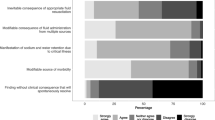Abstract
Goals of work
This article seeks to address the lack of information in the literature, by providing preliminary findings on the experience of managing catastrophic bleeds for haematology patients, from the perspective of health professionals involved in the care of such patients and their families.
Materials and methods
Insights from qualitative interviews with seventeen (n = 17) haematological nurses, four (n = 4) palliative care nurses and fifteen (n = 15) haematologists, conducted as part of a 2-year major national study on haematology and palliative care funded by the National Health and Medical Research Council, Australia. The interviews were audio-recorded and transcribed verbatim. The language texts were coded and analysed thematically.
Main results
The findings indicate that there is considerable controversy about the provision of clinical and supportive care to haematology patients who are vulnerable to catastrophic bleeds, including such issues as whether it is possible to identify individuals likely to be affected, the role of blood products, and whether it is wise to warn family or carers. The insights from the health professionals also highlight a number of practical suggestions including: the use of dark towels to reduce the distress of the visibility of the bleed; the importance of advance planning for care; accepting the limits of the situation; reassuring family that the patient is likely to lapse into lack of consciousness and will not be suffering, and the administration of sedation.
Conclusions
The important recommendation from this research is the resounding need for further work on this topic in order to provide clear guideline for best practice in clinical and supportive care.
Similar content being viewed by others
References
Aderka D, Praff G, Santo M (1986) Bleeding due to thrombocytopenia in acute leukemias and reevaluation of the prophylactic platelet transfusion policy. Am J Med Sci 291:147–151 doi:10.1097/00000441-198603000-00001
Crombie I (1996) Research in health care. Wiley, New York
Gagnon B, Mancini I, Pereira J, Bruera E (1998) Palliative management of bleeding events in advanced cancer patients. J Palliat Care 14:50–54
Gaskill D, Henderson A, Fraser M (1997) Exploring the everyday world of the patient in isolation. ONF 24(4):695–700
Greenhalgh T, Taylor R (1997) Papers that go beyond numbers. BMJ 315:740–743
Krathwohl D (1993) Methods of educational and social science research: an integrated approach. Longman, New York
Lassauniere J, Bertolino M, Hunault M, Zittoun R, Berspieren P, Moh-Klaren J et al (1996) Platelet transfusion in advanced hematological malignancies: A position paper. J Palliat Care 12:38–41
McGrath P (2007) Care of the haematology patient and their family—the GP viewpoint. Aust Fam Physician 36(9):799–781 September
McGrath P, Holewa H (2006) Missed opportunities: nursing insights on end-of-life care for haematology patients. Int J Nurs Pract 12(5):295–301 doi:10.1111/j.1440-172X.2006.00585.x
McGrath P, Holewa H (2006) Haematology and palliative care: towards an integrated practice. NHMRC funded booklet, CQU, Rockhampton
McGrath P, Holewa H (2007) Special considerations for haematology patients in relation to end-of-life care: Australian findings. Eur J Can Care 16(2):164–171 doi:10.1111/j.1365-2354.2006.00745.x
McGrath P, Holewa H (2007) A model for end-of-life care in haematology: an Australian nursing perspective. ONF 34(1):79–85 doi:10.1188/07.ONF.79-85
McGrath P, Joske D (2002) Palliative care and haematological malignancy: a case study. Aust Health Rev 25(31):60–66
Pereira J, Phan T (2004) Management of bleeding in patients with advanced cancer. Oncologist 9:561–570
Pihusch M (2004) Bleeding complications after hematopoietic stem cell transplantation. Semin Hematol 41(1):93–100 doi:10.1053/j.seminhematol.2003.11.018
Polit D, Hungler B (1995) Nursing research: principles and methods, 5th edn.Lippincott, Philadelphia
Prommer E (2005) Management of bleeding in the terminally ill patient. Hematology 10(3):167–175 doi:10.1080/10245330500093237
Sorrell J, Redmond G (1995) Interviews in qualitative nursing research: differing approaches for ethnographic and phenomenological studies. JOAN 21:1117–1122
Spiegelberg H (1975) Doing phenomenology. Nijhoff, The Hague
Stalfelt AM, Brodin H, Pattersson S, Eklof A (2003) The final phase in acute myeloid leukaemia (AML). A study on bleeding, infection and pain. Leuk Res 27:481–488 doi:10.1016/S0145-2126(02)00262-X
Streubert J, Carpenter D (1995) Qualitative research in nursing: advancing the humanistic imperative. J. B Lippincott Company, New York
Therapeutic Guidelines Limited (TGL) (2008) Therapeutic Guidelines. Guidelines International Network, North Melbourne, Victoria, (http://www.tg.com.au) accessed 24th March, 2008)
Van Manen M (1990) Researching lived experience. State University of New York Press, Ontario
Young NS, Gerson SL, High KA (2006) Clinical hematology. Elsevier, New York, 393. 25
Author information
Authors and Affiliations
Corresponding author
Rights and permissions
About this article
Cite this article
McGrath, P., Leahy, M. Catastrophic bleeds during end-of-life care in haematology: controversies from Australian research. Support Care Cancer 17, 527–537 (2009). https://doi.org/10.1007/s00520-008-0506-1
Received:
Accepted:
Published:
Issue Date:
DOI: https://doi.org/10.1007/s00520-008-0506-1




